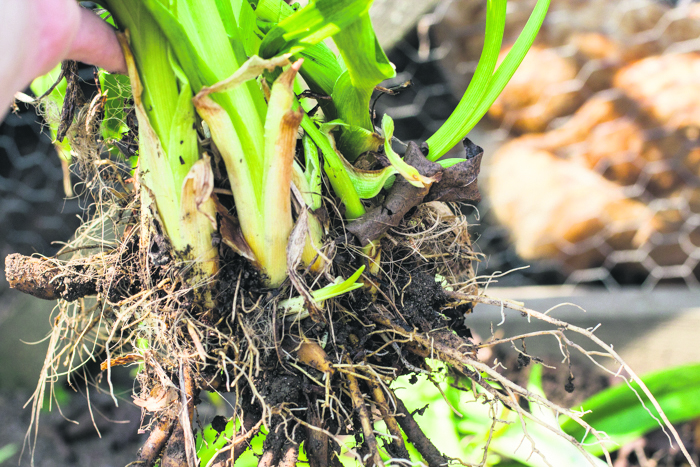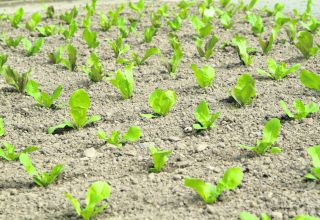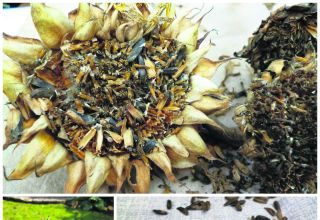
Timing is everything when it comes to bringing new life and vigorous growth to your plants by splitting your perennials
One of the wonders in a garden is the opportunity to rejuvenate even the oldest plants by dividing them and bringing them into new vigorous life.
When dividing perennials, timing and technique are important. Perennial plants are healthiest and most productive when they are young and have room to spread.
It’s a myth that all plants benefit from regular division. Many can be left for several years before they need dividing. Dividing plants is done for two reasons, to get more plants, or to restore vigour.
Generally, those plants that form a dead patch in the middle need rejuvenating.
There was a time when every herbaceous perennial was divided yearly – but this isn’t the case now. Nowadays you only need to split most if your plants are either losing vigour, or if you want to propagate more.
‘Dividing plants is done for two reasons, to get more plants, or to restore vigour’
Don’t wait until a plant has become decrepit or monstrous to divide it. One rule of thumb is when it looks its best, divide it at the end of that year.
Watch for the early signs of trouble: when the centre of the plant has smaller leaves, fewer flowers, and weaker blooming stalks than the outer edges or when the plant runs out of growing room on its edges and has nowhere to go but into neighboring plants.
The well-accepted rule regarding dividing hardy herbaceous plants is:
If it flowers before Midsummer’s Day – generally 21st June – you should divide it in autumn, allowing it plenty of time to recover.
If it flowers after Midsummer’s Day you should divide in spring, just as the growth re-shoots.
However, those who garden on heavy, waterlogged clay will lose plants if they’re divided in the autumn. So if you’re on heavy clay you should wait until spring before lifting anything, or indeed planting anything.
Basically, you need to divide just as the new foliage emerges. So earlier flowering plants, which shoot from the base first, can be divided in early spring. Later flowering plants, which shoot later, should be left until late spring.
How to divide
You will need two border forks, a spade and a tarpaulin.
Lift the whole plant and drag it onto the tarpaulin.
If the roots can be teased between the fingers (as they can with many perennials) pull away some of the outer pieces, because these are the most vigorous, and discard the middle section.
Shake off the soil and replant individual pieces.
Water well.
If your plant resists your fingers, use two forks back to back and lever pieces away by pulling the handles in opposing directions. Shake off the soil and replant the vigorous outer pieces.
Larger pieces separated like this can be planted straight back into ground enriched with a slow release fertiliser – like blood, fish and bone. Smaller pieces are often best potted up in soil based John Innes number 2. These can be planted out properly once the roots reach the bottom of the pot – usually after four to six weeks.
If the rootstock is solid or woodier,try the spade. Failing this, use a large knife or a saw to cut into the rootstock. Don’t cut solid rootstocks into small pieces. These woodier roots are often best done in late spring when the soil is warmer. Achilleas and all irises are also best divided in late spring as well.
Dividing tender plants
Divide tender plants in late spring, when the soil is warm. Agapanthus, kniphophia and alstroemeria come into this category. Keep well watered.
Members of the daisy family can also be raised from basal cuttings taken from the new growth. Aim to take some cuttings when the new growth is three inches in length. Just take a knife and remove the shoot above a node, the bumpy bit where the leaves emerge. Pot the cutting up into gritty compost, either in a pot or in small seed tray.
If you remove a wheelbarrow full of perennials, then you should put a wheel-barrow full of compost back into that site before replanting to renew the soil, stay ahead of pest problems, and maintain fertility. Without additions, the plants will not have the advantage of renewed, fertile soil and the bed will settle after planting, putting the plants at a disadvantage in terms of drainage and air circulation.

What plants need regular division?
Most plants can stay undivided for many years without being a problem. But some, such as heleniums and phloxes, are the exception. They need regular division every second or third year to maintain vigour.
Do follow your instincts because plants can vary in vigour. If a plant is doing well, leave it well alone.
Plants with fleshy roots, such as heucheras and primulas, are best divided regularly once the plants become lax and leggy.
Why divide?
• It will keep your plants healthy. Many perennials grow quickly, forming large clumps. If you don’t divide them every three to four years, these clumps can die out in the middle.
• Protect plants from fungal diseases and insect infestations.
• It will keep them beautiful. Overcrowded perennials often have fewer and/or smaller flowers than their well-spaced and divided counterparts. If your perennials are drastically in need of division, they may even appear stunted.
• Keep them in bounds. Some perennials are especially vigorous or even aggressive. Dividing these plants will help keep them from overwhelming their neighbours.
• Make more plants. Dividing perennials leaves you with more plants of the same variety – perfect for adding to other places in the garden.
What not to divide
Hellebores do not respond well to being divided. If you do so, cut into large sections and not small noses.
Dieramas hate being divided. Leave them to get on with it.
Japanese anemones, which have roots like thin shoelaces, place themselves. Lift them in late winter and early spring and lay the roots on to trays of light compost.
Some plants are tap-rooted and therefore can’t be divided successfully, however they usually produce copious amounts of seed. Tap-rooted plants such as most verbascums, most eryngiums, hollyhocks, most poppies, acanthus and lupins are raised by root cuttings taken in very early spring.











